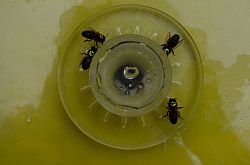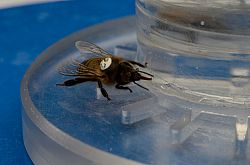Plants trick bees with caffeine-laced nectar
Plants may be tricking bees into repeatedly visiting their flowers by exploiting their craving for caffeine, a new University of Sussex-led study has found.
 Honey bees at feeder with caffeinated sucrose solution
Honey bees at feeder with caffeinated sucrose solution
Honey bees find the buzz of the drug so irresistible, the researchers say, that they choose caffeinated nectar over equal quality food that does not contain caffeine.
As a result, plants may be lacing their nectar with caffeine as a way to pass off sub-standard forage.
Dr Margaret Couvillon of the University’s Laboratory of Apiculture and Social Insects (LASI) led the study, published in the Cell Press journal Current Biology yesterday (Thursday 15 October).
Dr Couvillon says: “These new findings are a reminder that, while mutually dependent, the interests of plants and pollinators don’t always align.
“Some plants, through the action of a secondary compound like caffeine that is present in nectar, may be tricking the honey bee by securing loyal and faithful foraging and recruitment behaviours, perhaps without providing the best quality forage.”
 Close up of honey bee feeding on caffeinated sucrose solution
Close up of honey bee feeding on caffeinated sucrose solution
Dr Couvillon and her colleagues were aware of earlier studies that found that honey bees are better at learning and remembering particular scents when they are under the influence of caffeine. The findings suggested a role for reward pathways in the bees’ brains.
“I could not help but wonder how caffeine would affect the natural behaviours as seen in the field,” Dr Couvillon says, noting that the nectar of many flowering plants contains caffeine in low concentrations.
To investigate, the researchers tested bees’ responses to a sucrose solution with field-realistic doses of caffeine or without. They found that the caffeine caused honey bees to forage more and to direct their friends to the caffeinated forage more frequently using a unique behavioural technique called a ‘waggle dance’. The caffeine quadrupled the recruitment dances of bees to those feeders in comparison to uncaffeinated controls.
Bees were also more persistent about returning to sites where they’d previously found caffeinated nectar, even after the feeder had run dry. After sipping caffeine, bees were also less inclined to search for other resources, a behaviour that could be problematic when the well runs dry.
